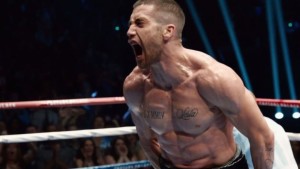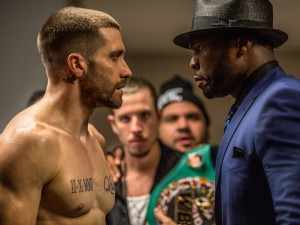Jake Gyllenhaal wowed us last year in the role of a Nightcrawler, where he scoured the streets of Los Angeles looking for the bloodiest and most violent story to sell to the local news. He’s back in another gritty role in Southpaw, but this one required a whole different look from the esteemed actor.
In Nightcrawler, Gyllenhaal lost tons of weight and reported having to go to the set every day being “hungry,” both physically and emotionally. In Southpaw, Gyllenhaal had to show up ripped and looking the part of a championship boxer, almost the polar opposite of the emaciated ambulance chaser.
The Movie Mensch caught up with Gyllenhaal and honestly wondered the timeline of how he made these two movies, along with the survival tale Everest (which is coming later this year), and the physical toll.
“I did Nightcrawler, then I did Everest, and then I did Southpaw. So we shot a majority of Everest in the Dolomites on the Austrian/Italian border. So there was a lot of really good pasta. So, I finished Nightcrawler and then I went into that, and then the training started for Southpaw. I spent five months training for this movie, two times a day, because I didn’t really know how to box when I started. I figured if I trained twice a day over five months that’d make 10 months,” Gyllenhaal said.
“I was motivated totally by fear that I would look like a fool, knowing how Antoine (Fuqua, director) was going to shoot the movie — which was no double, [and] shoot it like an HBO/Showtime fight where he’s going to have the real cameramen there. It was going to be medium shots and full body shots where you are going to see footwork. I’m going to be moving around, not just going to shoot from one side and cut. You are going to move from the back of your head all the way to the front of your head.”
Gyllenhaal needed to be more than ready. He trusted his director because he knows that nowadays, there really is no excuse for making a boxing movie any other way.
“We’ve seen it so many times. You can’t fake it anymore like that. You have to do it that way. And short of hiring a boxer who can act, I had to become an actor who could box. That was basically the discussion we had,” Gyllenhaal said.
“It wasn’t like every day I went in and I was just always going crazy. I would spend sometimes the mornings and we would just work technique. I remember days upon days when we were just working on my jab. I’m just shuffling around the ring working on footwork — backing up, moving forward, sideways, pivoting, backing up, moving forward, sideways, pivoting, moving forward, moving forward, back, back, back, oh, punch, move back, oh, punch. And then he’d hit me, back up, back up — hours upon hours of that.”
Gyllenhaal also found it an interesting challenge to play a character that has anger issues, but that, in many ways, is part of his job requirement. It allowed the actor to look inside at himself and analyze his emotions a little differently.
“He’s an angry character full of rage. I’m quick to jump at things, and I have my own responses. And I was interested in kind of exploring my own rage. So, at first, when I was training… I was in exploration, right? I was looking for motivating things. In boxing, I thought, ‘OK. If I start off, I go hard. If I go hard, I can get angry. If I go hard, that’s going to give me the fuel I need. Put on that hardcore music. That will give me the fuel I need.’ Then I’d get exhausted so quick. I’d be like, ‘Wait. That doesn’t work,’” Gyllenhaal admitted.
He had to find a motivation beyond pure anger to make Southpaw truly work. “All of a sudden, I started to realize a technique, sort of meditation, a relaxation. My motivation for this was really the idea of family and what you would do for family and your love of your family. My love of the children in my life in particular, like my nieces, I would do anything. That was a motivating factor in this one.”



